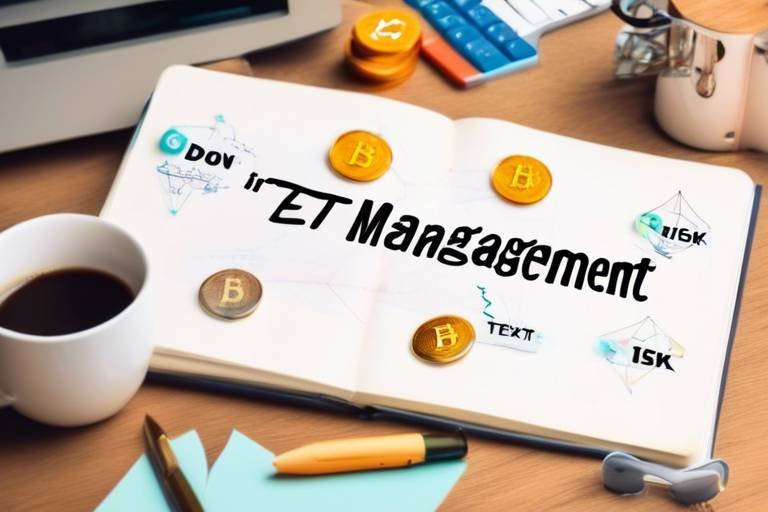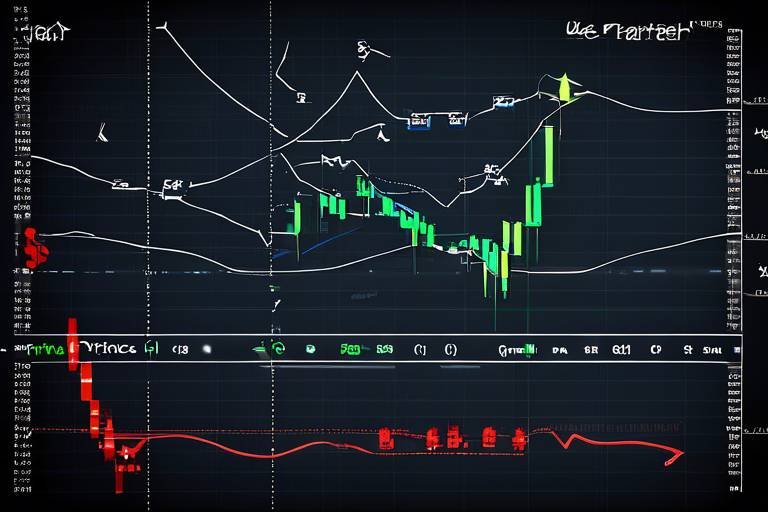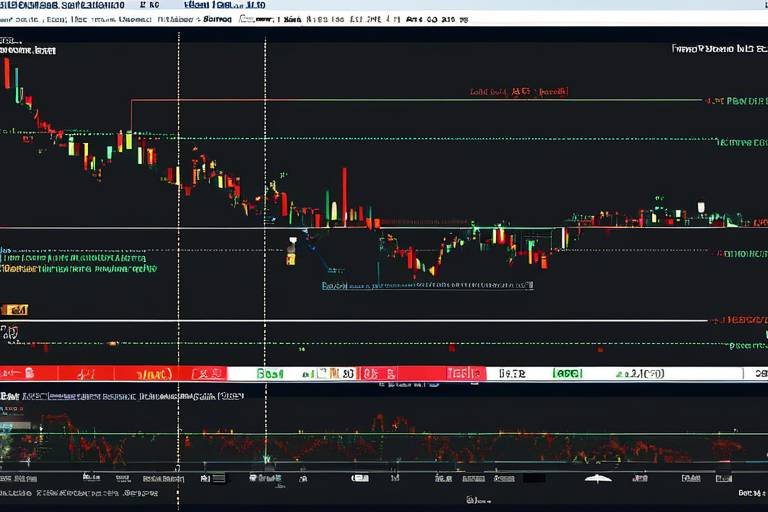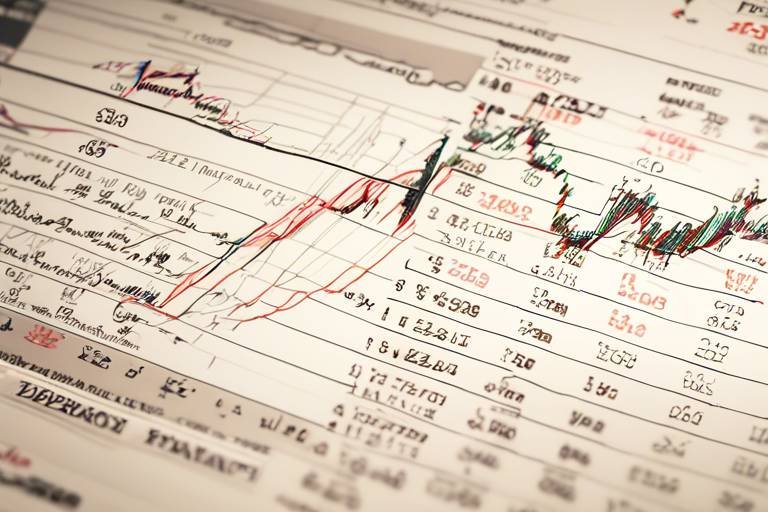Understanding the Importance of Risk Management in Crypto
In the ever-evolving world of cryptocurrency, where fortunes can be made and lost in the blink of an eye, understanding the importance of risk management is not just beneficial—it's essential. Imagine you're navigating a ship through a stormy sea; without a solid plan to steer clear of the rocks, you're bound to face disaster. Similarly, in crypto trading, having a robust risk management strategy can mean the difference between thriving and merely surviving.
The cryptocurrency market is notorious for its high volatility, where prices can swing dramatically within hours. This unpredictability can induce a sense of excitement, but it can also lead to significant losses if not handled properly. Therefore, grasping the nuances of risk management is crucial for anyone looking to invest in this space. It’s about more than just protecting your capital; it’s about enhancing your decision-making process and ensuring that you can weather the storms that this market throws your way.
One of the key aspects of risk management is understanding the various types of risks associated with cryptocurrency investments. These can include market risk, liquidity risk, and regulatory risk, each presenting unique challenges. By identifying these risks early on, investors can tailor their strategies to mitigate potential losses.
To illustrate, let’s consider the types of risks:
| Type of Risk | Description |
|---|---|
| Market Risk | The potential for losses due to price fluctuations in the cryptocurrency market. |
| Liquidity Risk | The risk of not being able to buy or sell assets quickly without causing significant price changes. |
| Regulatory Risk | The potential for changes in laws or regulations that could adversely affect the market. |
By understanding these risks, investors can implement strategies that not only protect their investments but also enhance their overall trading experience. This includes employing tools and techniques that allow for better decision-making, such as technical and sentiment analysis. These methods can provide valuable insights into market trends and investor psychology, helping to navigate the often-turbulent waters of cryptocurrency trading.
In conclusion, risk management is not merely a precaution; it is a fundamental aspect of successful cryptocurrency investing. By embracing a proactive approach to risk, you can not only safeguard your investments but also position yourself to capitalize on the incredible opportunities that the crypto market offers.
- What is risk management in cryptocurrency? Risk management in cryptocurrency involves strategies and tools to minimize potential losses and make informed investment decisions.
- Why is risk management important? It helps investors protect their capital, navigate volatility, and enhance decision-making processes in a highly unpredictable market.
- What are common risk management strategies? Common strategies include diversification, setting stop-loss orders, and conducting thorough market analysis.

The Volatility of Cryptocurrency Markets
The world of cryptocurrency is like a rollercoaster ride; it’s thrilling, unpredictable, and can leave you breathless. The extreme price fluctuations in the crypto markets are not just common—they're expected! This volatility is largely influenced by a variety of factors, and understanding these can be the key to navigating the tumultuous waters of digital currency investment.
First off, let’s talk about the market dynamics. Unlike traditional financial markets, which may have a more stable foundation, cryptocurrencies are often driven by speculative trading. This means that emotions, news, and social media trends can cause prices to swing wildly in a matter of hours. For instance, a single tweet from a high-profile influencer can send a cryptocurrency soaring or plummeting. Imagine being on a seesaw where one side is controlled by the whims of public opinion and the other by market trends—it's no wonder investors feel dizzy!
Moreover, the liquidity of a cryptocurrency plays a significant role in its volatility. If a coin has low trading volume, even a small buy or sell order can dramatically affect its price. This is akin to trying to fill a small cup with a fire hose; too much pressure can cause overflow and chaos. Conversely, highly liquid cryptocurrencies tend to have more stable prices because large trades can be executed without significant price changes.
Additionally, regulatory news can shake up the market like a sudden earthquake. When governments announce new regulations or crackdowns on cryptocurrencies, it can lead to panic selling or buying, further exacerbating price swings. For instance, when China announced its ban on cryptocurrency transactions, the market took a nosedive, affecting prices globally. Investors must be aware of these external factors and how they can ripple through the market.
To illustrate the impact of volatility, let’s look at a
| Cryptocurrency | Price Range (in USD) | Volatility Index |
|---|---|---|
| Bitcoin (BTC) | $30,000 - $70,000 | High |
| Ethereum (ETH) | $1,000 - $4,500 | High |
| Dogecoin (DOGE) | $0.01 - $0.70 | Very High |
| Ripple (XRP) | $0.25 - $1.50 | Moderate |
In conclusion, understanding the volatility of cryptocurrency markets is crucial for any investor looking to make informed decisions. By keeping an eye on market trends, liquidity, and regulatory news, you can better prepare yourself for the ups and downs of this exciting investment landscape. Remember, while the thrill of high rewards can be enticing, a solid grasp on risk management can make all the difference between a successful investment and a costly mistake.
- What causes cryptocurrency volatility? Cryptocurrency volatility is primarily caused by market speculation, liquidity issues, and regulatory news.
- How can I manage risk in a volatile market? Implementing strategies like diversification, using stop-loss orders, and staying informed about market trends can help manage risk.
- Is volatility a bad thing for investors? Not necessarily. While it can lead to losses, volatility also presents opportunities for significant gains if managed correctly.

Types of Risks in Cryptocurrency
Investing in cryptocurrencies can be an exhilarating ride, but it’s not without its bumps and bruises. The digital currency landscape is riddled with various types of risks that every investor should be aware of. Understanding these risks is not just a precaution; it’s a necessity if you want to navigate this volatile terrain successfully. Let’s dive into the main types of risks that can affect your cryptocurrency investments.
First and foremost, we have market risk, which is the potential for losses due to price fluctuations in the cryptocurrency market. Imagine riding a roller coaster: one moment you’re soaring high, and the next, you’re plunging down. This is how market risk operates. Prices can swing dramatically based on market sentiment, news events, or even tweets from influential figures. To mitigate this risk, investors need to analyze market trends and sentiment carefully.
Another critical risk is liquidity risk. This occurs when an investor cannot buy or sell a cryptocurrency quickly without causing a significant price change. Think of it as trying to sell a rare collectible; if there aren’t enough buyers, you may have to sell at a much lower price than expected. Recognizing the importance of liquidity can help you avoid potential losses during market downturns. For instance, if a cryptocurrency has low trading volume, it might be challenging to exit your position without taking a hit on the price.
Finally, we cannot overlook regulatory risk. The cryptocurrency landscape is constantly evolving, with governments around the world grappling to regulate this new asset class. Changes in regulations can significantly impact the market, sometimes causing prices to plummet overnight. Staying informed about the regulatory environment in your jurisdiction is crucial for safeguarding your investments.
In summary, the three primary types of risks in cryptocurrency investing are:
- Market Risk: Fluctuations in price due to market sentiment.
- Liquidity Risk: Difficulty in buying or selling assets without affecting the price.
- Regulatory Risk: Changes in laws and regulations that could impact the market.
By identifying and understanding these risks, you can create a comprehensive risk management plan tailored to your individual investment goals. Remember, knowledge is power, especially in the fast-paced world of cryptocurrency!
Q: What is market risk in cryptocurrency?
A: Market risk refers to the potential for losses due to price fluctuations in the cryptocurrency market. Investors must analyze market trends and sentiment to minimize exposure to this risk.
Q: How can I mitigate liquidity risk?
A: You can mitigate liquidity risk by investing in cryptocurrencies with higher trading volumes and ensuring that you’re aware of the market conditions before making trades.
Q: What should I do if regulations change?
A: Stay informed about regulatory changes and be prepared to adapt your investment strategy accordingly. This may involve diversifying your portfolio or adjusting your positions based on new laws.

Market Risk
Market risk is a fundamental concept that every cryptocurrency investor should grasp. It refers to the potential for losses that arise from fluctuations in the prices of cryptocurrencies. Just think about it: one moment, your favorite coin is soaring to new heights, and the next, it’s plummeting faster than a lead balloon. This unpredictability can be both thrilling and terrifying, especially for those who are new to the crypto space. Understanding market risk is not just about knowing that prices can change; it’s about analyzing why they change and how you can better prepare yourself for these shifts.
To effectively manage market risk, investors must dive into the depths of market trends and sentiment. This involves a keen eye on various factors that influence price movements, such as market news, technological advancements, and even social media buzz. For instance, when a major exchange lists a new cryptocurrency, it can lead to a surge in demand, driving prices up. Conversely, negative news, like regulatory crackdowns, can send prices spiraling downward. Hence, staying informed is crucial.
One effective way to minimize exposure to market risk is through technical analysis. This technique involves studying historical price data and chart patterns to predict future price movements. By recognizing recurring patterns, investors can make more informed decisions about when to buy or sell. Imagine you’re a sailor navigating through stormy seas; understanding the waves (or market trends) helps you steer your ship safely to shore.
In addition to technical analysis, sentiment analysis plays a vital role in understanding market risk. This method gauges the mood of the market by analyzing news articles, social media posts, and community discussions. For example, if a significant amount of positive sentiment is detected around a particular cryptocurrency, it may indicate a potential price increase. Conversely, if the sentiment turns negative, it could be a warning sign to reassess your investment. By combining both technical and sentiment analysis, you can create a more comprehensive strategy to manage market risk effectively.
In summary, market risk is an ever-present challenge in the cryptocurrency world. By mastering technical and sentiment analysis, you can navigate the volatile waters of crypto trading with greater confidence. Remember, it’s not just about riding the waves; it’s about understanding them and knowing when to adjust your sails.
Frequently Asked Questions
- What is market risk in cryptocurrency? Market risk refers to the potential for losses due to price fluctuations in the cryptocurrency market.
- How can I minimize market risk? You can minimize market risk by using technical analysis, sentiment analysis, and staying informed about market trends.
- Why is understanding market sentiment important? Market sentiment provides insights into potential price movements and helps investors make informed decisions.

Technical Analysis Techniques
When it comes to navigating the turbulent waters of cryptocurrency trading, technical analysis serves as a beacon of light. It’s like having a map in an uncharted territory, guiding you through the unpredictable price movements of digital assets. By leveraging historical price data and chart patterns, investors can forecast potential future price movements, making it an essential tool for anyone serious about minimizing risk in this volatile market.
One of the fundamental concepts in technical analysis is the use of support and resistance levels. Support is the price level at which a downtrend can be expected to pause due to a concentration of demand. Conversely, resistance is where an uptrend can be expected to pause due to a concentration of supply. Understanding these levels can significantly enhance your decision-making process. For instance, if a cryptocurrency approaches a strong support level, it might be a good opportunity to buy, anticipating a bounce back. On the other hand, if it nears a resistance level, it could be wise to sell or set a stop-loss to protect your gains.
Another critical technique is the application of moving averages. Moving averages smooth out price data to create a trend-following indicator. By calculating the average price over a specific period, traders can identify the direction of the trend. For example, a 50-day moving average can help you see whether the price is trending upwards or downwards. When the current price crosses above the moving average, it might indicate a buying opportunity, while a cross below could signal a sell.
Additionally, candlestick patterns are invaluable in technical analysis. Each candlestick provides a visual representation of price movements over a specific time frame, showing the open, close, high, and low prices. Recognizing patterns such as doji, hammer, or engulfing patterns can provide insights into market sentiment. For instance, a doji indicates indecision in the market, while a hammer might suggest a potential reversal after a downtrend. Understanding these patterns can empower investors to make more informed choices.
Lastly, incorporating indicators such as the Relative Strength Index (RSI) and Moving Average Convergence Divergence (MACD) can further enhance your analysis. The RSI measures the speed and change of price movements, helping to identify overbought or oversold conditions. Meanwhile, MACD is a trend-following momentum indicator that shows the relationship between two moving averages of a security’s price. Both tools can assist traders in making timely decisions, allowing them to enter or exit positions more effectively.
In summary, mastering technical analysis techniques is akin to learning the rules of a complex game. It requires practice and patience, but the rewards can be substantial. By understanding support and resistance levels, utilizing moving averages, recognizing candlestick patterns, and implementing key indicators, investors can navigate the cryptocurrency market with greater confidence and reduce their exposure to risks.
- What is technical analysis? Technical analysis involves analyzing historical price data and chart patterns to forecast future price movements in the market.
- Why is technical analysis important in cryptocurrency trading? It helps investors make informed decisions by identifying trends and potential market reversals, ultimately aiding in risk management.
- What are some common technical indicators? Common indicators include Moving Averages, Relative Strength Index (RSI), and Moving Average Convergence Divergence (MACD).
- Can technical analysis guarantee profits? While it can significantly enhance decision-making, it does not guarantee profits due to the inherent volatility of cryptocurrency markets.

Sentiment Analysis
When it comes to navigating the choppy waters of cryptocurrency trading, serves as a beacon, guiding investors through the fog of uncertainty. Essentially, sentiment analysis is the practice of gauging the mood of the market by examining various sources such as news articles, social media platforms, and community forums. By understanding how the collective mindset of investors shifts, you can make more informed decisions that align with market trends.
Imagine you're at a party, and the vibe is electric—everyone is excited and talking about the latest cryptocurrency. This buzz can lead to a surge in prices. Conversely, if the atmosphere turns sour, with whispers of regulatory crackdowns or security breaches, you might notice a sharp decline in enthusiasm and, consequently, in prices. Recognizing these shifts in sentiment can be the difference between riding the wave to profits and getting swept under.
To effectively conduct sentiment analysis, investors often utilize a mix of qualitative and quantitative methods. For instance, qualitative analysis involves reading through articles and posts to assess the general tone—are people feeling optimistic or pessimistic? On the other hand, quantitative analysis might involve using algorithms to analyze the frequency of certain keywords or phrases related to a specific cryptocurrency. By combining both methods, you can create a well-rounded view of the market’s sentiment.
Here are some key factors that can influence market sentiment:
- News Events: Major announcements, partnerships, or technological advancements can create waves of positivity or negativity.
- Social Media Trends: Platforms like Twitter and Reddit are hotbeds for real-time sentiment shifts. Monitoring hashtags and discussions can provide early warnings about market movements.
- Market Trends: Historical price movements often influence current sentiment. If a cryptocurrency has been on a downward trend, investors may feel hesitant, even if the fundamentals remain strong.
Moreover, sentiment analysis can also be enhanced by utilizing various tools and platforms designed for this purpose. For example, tools like Google Trends can help you track the popularity of certain cryptocurrencies over time, while platforms like Crypto Fear & Greed Index provide insights into market psychology. By integrating these tools into your trading strategy, you can better anticipate market movements and adjust your portfolio accordingly.
In conclusion, sentiment analysis is not just a buzzword; it’s a crucial component of a successful risk management strategy in cryptocurrency trading. By understanding the collective emotions of the market, you can make smarter, more calculated decisions that ultimately lead to better investment outcomes. After all, in a market as unpredictable as crypto, having your finger on the pulse of sentiment can be your greatest asset.
Q: What is sentiment analysis in cryptocurrency?
A: Sentiment analysis is the process of evaluating the mood of the market by analyzing news, social media, and community discussions to gauge investor sentiment.
Q: Why is sentiment analysis important?
A: It helps investors anticipate market movements and make informed decisions, reducing the risk of losses during volatile periods.
Q: How can I conduct sentiment analysis?
A: You can conduct sentiment analysis by reading news articles, monitoring social media trends, and using specialized tools to quantify market sentiment.
Q: Are there any tools for sentiment analysis?
A: Yes, tools like Google Trends and the Crypto Fear & Greed Index can provide valuable insights into market sentiment.

Liquidity Risk
Liquidity risk is a critical aspect of cryptocurrency investing that often flies under the radar. It refers to the potential losses that can occur when an investor is unable to buy or sell an asset quickly without significantly impacting its price. Imagine trying to sell a rare painting in a market filled with buyers for common art pieces; you might have to lower your price dramatically just to make a sale. Similarly, in the crypto market, if you hold a less popular cryptocurrency, you might find it challenging to sell without incurring losses due to a lack of buyers.
The cryptocurrency market is notoriously volatile, and liquidity can vary greatly between different cryptocurrencies. High liquidity means there are plenty of buyers and sellers, which allows for smoother transactions. On the other hand, low liquidity can lead to large price swings, making it difficult to execute trades at desired prices. This is particularly concerning during market downturns when panic selling can occur, and prices can plummet before you even have a chance to react.
To illustrate the concept of liquidity risk, consider the following table that compares different cryptocurrencies based on their liquidity levels:
| Cryptocurrency | Market Capitalization | Liquidity Level |
|---|---|---|
| Bitcoin (BTC) | $800 billion | High |
| Ethereum (ETH) | $400 billion | High |
| Ripple (XRP) | $25 billion | Medium |
| Dogecoin (DOGE) | $10 billion | Medium |
| RareCoin (RARE) | $50 million | Low |
As seen in the table, Bitcoin and Ethereum enjoy high liquidity due to their massive market capitalizations and widespread acceptance. In contrast, RareCoin, with its significantly lower market cap, presents a liquidity risk that could lead to unfavorable trading conditions for investors. Therefore, it’s crucial to assess the liquidity of any cryptocurrency before investing, as it can greatly influence your ability to enter or exit positions without incurring substantial losses.
One effective way to manage liquidity risk is to focus on investing in cryptocurrencies with higher liquidity levels. This doesn't just apply to well-known coins like Bitcoin and Ethereum; there are many altcoins that also exhibit strong liquidity. Additionally, employing strategies such as limit orders can help mitigate the impact of liquidity risk by allowing you to set specific prices at which you are willing to buy or sell, rather than being forced to accept whatever price the market offers at the moment.
In summary, understanding liquidity risk is paramount for anyone looking to navigate the turbulent waters of cryptocurrency investing. By being aware of how liquidity affects your trades and taking steps to minimize this risk, you can enhance your overall investment strategy and protect your assets from unexpected market movements.
- What is liquidity risk in cryptocurrency? Liquidity risk refers to the potential losses that can occur when an investor is unable to buy or sell an asset quickly without significantly impacting its price.
- How can I manage liquidity risk? You can manage liquidity risk by investing in cryptocurrencies with higher liquidity levels and using limit orders to control your buy and sell prices.
- Why is liquidity important in crypto trading? Liquidity is important because it affects your ability to execute trades efficiently without causing significant price changes.

Developing a Risk Management Strategy
Creating a robust risk management strategy is vital for successful cryptocurrency investing. In a market characterized by rapid fluctuations and unpredictable trends, having a plan in place can mean the difference between profit and loss. So, where do you start? First and foremost, you need to set clear investment goals. Are you in it for the long haul, or are you looking for quick gains? Understanding your objectives will guide your entire strategy.
Next, it’s essential to determine your risk tolerance. This involves assessing how much you are willing to lose before you start to feel uncomfortable. Think of it like setting a speed limit for your investments; it helps you navigate the twists and turns of the market without crashing. Once you have a clear understanding of your goals and tolerance, you can begin to implement various risk mitigation techniques.
One effective method is diversification. By spreading your investments across different cryptocurrencies and asset classes, you can minimize risk. Imagine you’re planting a garden; if you only plant one type of flower, a pest could wipe out your entire crop. However, by diversifying, you ensure that even if one plant falters, others will thrive. A well-diversified portfolio can help reduce overall exposure to market volatility.
Another crucial tactic is setting stop-loss orders. These are like safety nets that automatically sell a cryptocurrency when it reaches a predetermined price, helping to limit potential losses. For instance, if you purchase Bitcoin at $40,000 and set a stop-loss order at $38,000, your investment will automatically sell if the price drops to that level, protecting you from further declines. This strategy allows you to manage risk effectively without needing to monitor the market constantly.
In addition to these techniques, it’s important to continuously monitor your investments and adjust your strategy as needed. The cryptocurrency market is ever-evolving, and what worked yesterday may not work tomorrow. Regularly reviewing your portfolio and being willing to make changes can help you stay ahead of the curve and mitigate risks more effectively.
Lastly, consider utilizing various tools and resources available in the market. There are numerous platforms that offer analytical tools, alerts, and insights that can assist you in making informed decisions. By combining your knowledge with these resources, you can enhance your ability to navigate the tumultuous waters of cryptocurrency investing.
- What is the best way to start developing a risk management strategy?
Begin by clearly defining your investment goals and assessing your risk tolerance. From there, implement techniques such as diversification and stop-loss orders. - How often should I review my risk management strategy?
It’s advisable to review your strategy regularly, especially in a volatile market like cryptocurrency. Adjustments may be necessary based on market conditions. - Can I use automated tools for risk management?
Absolutely! There are many platforms that offer automated trading tools and alerts, which can help you manage risk more efficiently.

Diversification of Investments
Diversification is a key principle in investing, and it holds particularly true in the cryptocurrency market, where volatility can be your worst enemy. Think of your investment portfolio like a garden: if you only plant one type of flower, a single pest can wipe out your entire garden. However, by planting various flowers, you create a resilient ecosystem that can withstand challenges. In the same vein, diversifying your investments across different cryptocurrencies and asset classes can significantly reduce your overall risk.
When you spread your investments, you’re not just putting all your eggs in one basket; you’re strategically positioning yourself to weather the storm of market fluctuations. For instance, while Bitcoin may be the dominant player, other cryptocurrencies like Ethereum, Cardano, and Solana each have unique value propositions and use cases. By including a mix of these assets in your portfolio, you can minimize the impact of a downturn in any single asset.
Moreover, diversification can also extend beyond cryptocurrencies. Consider incorporating traditional assets such as stocks, bonds, or commodities into your investment strategy. This approach helps to create a balanced portfolio that can perform well under various market conditions. By doing so, you not only protect your capital but also enhance your potential for long-term growth.
To visualize the benefits of diversification, here’s a simple table that outlines potential returns based on different asset allocations:
| Asset Allocation | Expected Annual Return (%) | Risk Level (1-10) |
|---|---|---|
| 100% Cryptocurrency | 20% | 9 |
| 70% Cryptocurrency, 30% Stocks | 15% | 7 |
| 50% Cryptocurrency, 50% Stocks | 12% | 5 |
| 40% Cryptocurrency, 30% Stocks, 30% Bonds | 10% | 4 |
As you can see, a more balanced portfolio can lead to a more stable return while reducing risk. But remember, diversification isn’t just about quantity; it’s about quality too. It’s essential to research each potential investment thoroughly and ensure they align with your overall investment strategy and risk tolerance.
In conclusion, diversification is not merely a strategy; it’s a mindset. Embracing this approach can empower you to navigate the turbulent waters of cryptocurrency investing with greater confidence. So, as you build your portfolio, always keep in mind the importance of spreading your investments wisely. After all, a well-diversified portfolio can be your best defense against the unpredictable nature of the crypto market.
- What is diversification in cryptocurrency investing? Diversification involves spreading your investments across various cryptocurrencies and other asset classes to reduce risk.
- Why is diversification important? It helps to mitigate the impact of losses from any single investment, providing a more stable overall portfolio performance.
- How can I diversify my cryptocurrency portfolio? You can invest in different cryptocurrencies, incorporate traditional assets like stocks and bonds, and explore various sectors within the crypto space.
- Is there a recommended percentage for diversification? While there is no one-size-fits-all answer, a common approach is to allocate a mix that aligns with your risk tolerance and investment goals.

Setting Stop-Loss Orders
This article explores the critical role of risk management in cryptocurrency trading and investment. It highlights strategies, tools, and best practices to mitigate risks and enhance decision-making in this volatile market.
Cryptocurrency markets are known for their extreme price fluctuations. Understanding the factors contributing to this volatility can help investors develop effective risk management strategies to protect their investments.
Investing in cryptocurrencies involves various risks, including market risk, liquidity risk, and regulatory risk. Identifying these risks is essential for creating a comprehensive risk management plan tailored to individual investment goals.
Market risk refers to the potential for losses due to price fluctuations in the cryptocurrency market. Investors must analyze market trends and sentiment to minimize exposure to this risk.
Technical analysis involves using historical price data and chart patterns to forecast future price movements. Mastering these techniques can help investors make informed decisions and manage market risk effectively.
Sentiment analysis gauges market sentiment through news, social media, and community discussions. Understanding market psychology can provide insights into potential price movements and assist in risk management.
Liquidity risk arises when an investor cannot buy or sell assets quickly without causing significant price changes. Recognizing the importance of liquidity can help investors avoid potential losses during market downturns.
Creating a robust risk management strategy is vital for successful cryptocurrency investing. This involves setting clear investment goals, determining risk tolerance, and employing various risk mitigation techniques.
Diversification involves spreading investments across different cryptocurrencies and asset classes to minimize risk. A well-diversified portfolio can help reduce overall exposure to market volatility.
Setting stop-loss orders is a crucial tactic in managing risk effectively. A stop-loss order is essentially a safety net that automatically sells your cryptocurrency when it hits a certain price point. Think of it as a protective shield that keeps your losses in check. By specifying a price at which you want to exit a trade, you can prevent emotional decision-making during those nail-biting market dips.
For example, if you bought a cryptocurrency at $100 and set a stop-loss order at $90, your asset would automatically sell if the price drops to $90. This way, you limit your potential loss to just $10. It's like having a parachute when you jump out of a plane—when things go south, you want to have that safety measure in place.
Moreover, stop-loss orders can be categorized into two main types:
- Standard Stop-Loss Orders: These are straightforward and execute a market order when the set price is reached.
- Trailing Stop-Loss Orders: These adjust the stop price at a fixed percentage or dollar amount below the market price, allowing for profit protection as the price rises.
Utilizing stop-loss orders not only safeguards your investments but also instills a sense of discipline in your trading strategy. It encourages you to stick to your plan and avoid the temptation to hold onto a losing asset in hopes of a rebound. In the fast-paced world of cryptocurrency, where emotions can cloud judgment, having a stop-loss order is akin to having a GPS guiding you through a chaotic traffic jam.
- What is a stop-loss order? A stop-loss order is an instruction to sell a cryptocurrency when it reaches a certain price to limit potential losses.
- How do I set a stop-loss order? You can set a stop-loss order through your trading platform by specifying the price at which you want to sell your asset.
- Are stop-loss orders foolproof? While stop-loss orders are effective, they are not guaranteed. In extremely volatile markets, prices may skip over your stop-loss price.
- Should I use trailing stop-loss orders? Trailing stop-loss orders can be beneficial as they allow you to lock in profits while still providing a safety net.
Frequently Asked Questions
- What is risk management in cryptocurrency?
Risk management in cryptocurrency refers to the strategies and practices that investors use to minimize potential losses while maximizing gains. It involves understanding the market's volatility, identifying various types of risks, and implementing techniques to mitigate those risks effectively.
- Why is understanding market volatility important?
Understanding market volatility is crucial because it helps investors anticipate price fluctuations and make informed decisions. By grasping the factors that contribute to these changes, investors can develop stronger risk management strategies to protect their investments from significant losses.
- What are the main types of risks associated with cryptocurrency?
The main types of risks in cryptocurrency include market risk, liquidity risk, and regulatory risk. Each of these risks can impact an investor's portfolio, making it essential to identify and address them when creating a risk management plan.
- How can technical analysis help in risk management?
Technical analysis helps investors forecast future price movements by analyzing historical price data and chart patterns. This knowledge enables them to make more informed decisions and reduce their exposure to market risk.
- What is sentiment analysis and why is it important?
Sentiment analysis involves gauging market sentiment through various channels like news, social media, and community discussions. Understanding the psychology behind market movements can provide valuable insights, helping investors make better decisions and manage risks more effectively.
- What is liquidity risk and how can it affect my investments?
Liquidity risk occurs when an investor cannot quickly buy or sell an asset without causing a significant price change. This can lead to potential losses, especially during market downturns, making it vital for investors to recognize and account for liquidity in their risk management strategies.
- How can I develop a robust risk management strategy?
To develop a robust risk management strategy, you should set clear investment goals, determine your risk tolerance, and employ various risk mitigation techniques, such as diversification and setting stop-loss orders. This comprehensive approach can help protect your investments in the volatile cryptocurrency market.
- What is diversification and how does it help?
Diversification involves spreading your investments across different cryptocurrencies and asset classes to minimize risk. By having a well-diversified portfolio, you can reduce your overall exposure to market volatility and protect your investments from significant losses.
- What are stop-loss orders and why should I use them?
Stop-loss orders are automated instructions to sell a cryptocurrency when it reaches a specific price point. They are essential for limiting potential losses and can be a crucial tactic in managing risk effectively, especially in a highly volatile market.



















